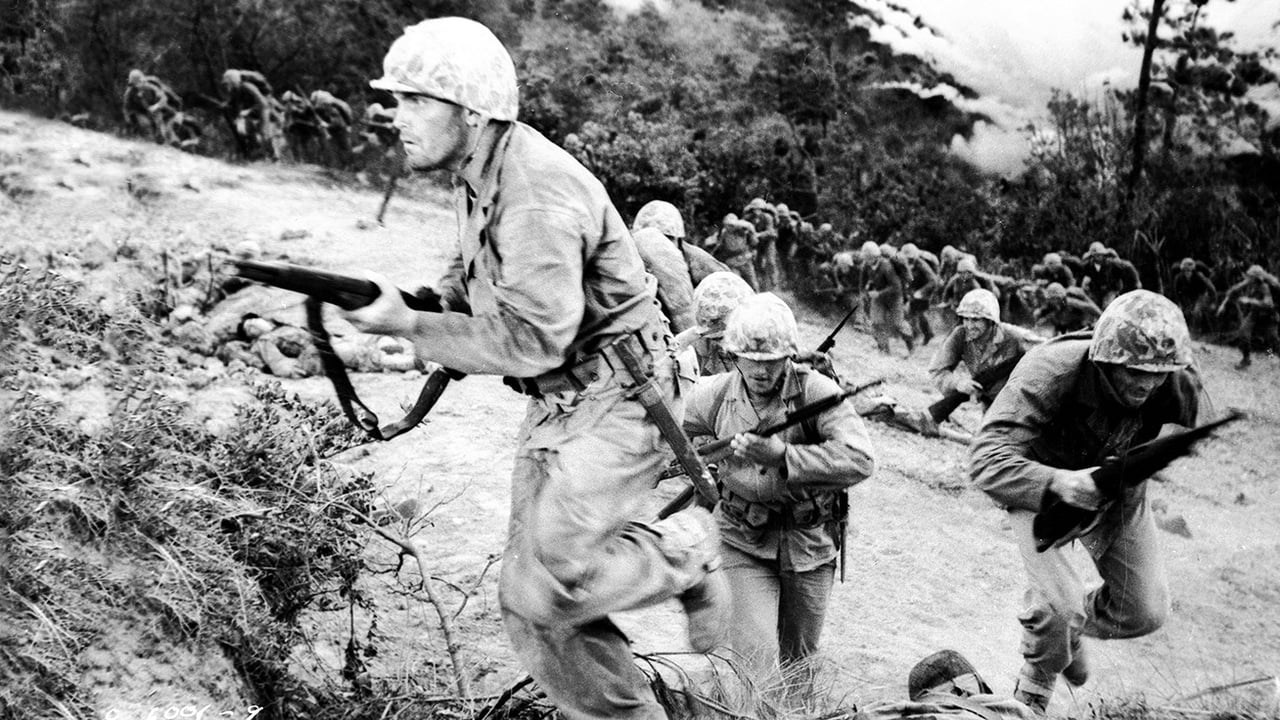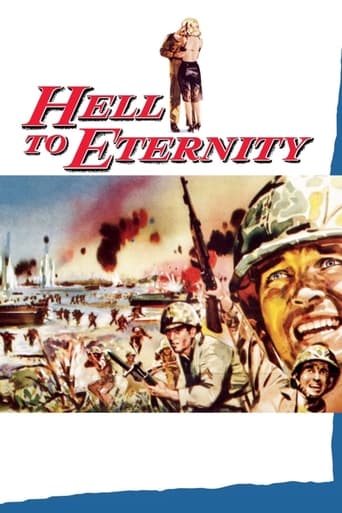

It's rare that I like the idea of a remake. Normally, the original film is MUCH better and remakes almost never stand up to the original movie. However, "Hell to Eternity" has an exceptional story--and with only a few small but obvious changes, it could be a great story...because it's true.This film is about a Marine named Guy Gabaldon. He was a Mexican-American who was orphaned and subsequently taken in by a nice Japanese-American family in the 1930s. When WWII came, his adoptive family was placed in an internment camp and two of his new adoptive brothers went to fight in Europe for the Army. Gabaldon volunteered to fight with the Marines in the Pacific and became an interpreter, since he could speak Japanese fluently. On the island of Saipan, like so many other islands occupied by the Japanese, folks committed suicide in huge numbers to avoid being captured by the Americans--a waste and a serious human tragedy. However, Gabaldon was able to use his skills to save many lives--making him a very unusual hero to say the least! As I said, there were a few problems with the film. First, although the movie was VERY progressive in dealing with anti-Japanese prejudices, the film was also prejudiced in its own way--having the VERY non-Hispanic Jeffery Hunter play the lead. Yes, his acting here was fine--but it also whitewashes the contributions of a minority member--and odd omission to say the least. Second, the middle portion of the film SERIOUSLY loses momentum and the entire stripper portion is very inappropriate. I am NOT anti-sex--but the this actually distracted the viewer and much of this portion is pretty dull. But, with these changes, it is a wonderful story! Well worth seeing.
... View MoreOutstanding war film. Based on a true story from WW II, of Guy Gabaldon, who single-handedly brought in more than 1,500 Japanese prisoners and civilians in the Battle of Saipan in 1944. Jeffrey Hunter and the entire cast are excellent. The movie is excellent also because of the portrayal of emotional conflict of Gabaldon. He was raised by Japanese Americans as an orphan, then had to fight and kill Japanese who killed his Army buddies. The film is a rare one in also showing the concern and care by the American combatants for the innocent Japanese civilians. And, it portrays well the conflicted psyche of the grunt Japanese soldiers and civilians who had been told by their leaders that the Americans were cruel barbarians, and that the Japanese must fight to the death or kill themselves and their children rather than surrender.Wikipedia has an interesting piece on Guy Gabaldon. It's always good to read some biographical info about a real person from the movies. It sounds as though he may have been a little more street tough than portrayed by Jeffrey Hunter. And, that he was a little more threatening of the Japanese soldiers holed up in caves. But, Hunter gives a great portrayal of the hero. Gabaldon must have liked the job Hunter did since he named one of his sons, Jeffrey Hunter Gabaldon. The only distraction in this great film is the night out the three main characters have with women before they go into combat. The heavy drinking and implied lovemaking probably represented what some GIs, Marines and Sailors did before going to war, but it surely didn't represent most. Few in the Army had such a chance -- once you were in battle you were there for the duration. Some units may have been moved back into reserves in Europe or the Pacific, but there sure weren't bars and girls for all-night parties there. So, this piece adds nothing to the film whatsoever. But, the main film and story, with excellent acting and action overrides any detraction to the film by this usual Hollywood gratuitousness.
... View MoreExcellent war movie. Excellent drama. Phil Karlson directs with less than an A-movie budget, but comes up with outstanding war action scenes and the best from his talented cast. The story is based on the real life story of Guy Gabaldon, who enlisted in the Marines and became a hero in the Battle of Saipan by persuading 2,000 Japanese soldiers to surrender. Guy was adopted by a Japanese family after his mother died. After Pearl Harbor, the young man from Chicago was turned down by the Army due to a split eardrum...but being able to speak Japanese fluently the Marines knew he was of use to his country.At this particular time HELL TO ETERNITY contained harsh and violent war action. Most of the brutality being needed to send the message of the urgency in this powerful story. Cabaldon as a child is played by Richard Eyer. The adult Cabaldon is portrayed flawlessly by Jeffrey Hunter, honestly and with no lack of emotion. Also in the cast: David Jansen, Vic Damone, Patricia Owens, George Takei, John Larch, Nicky Blair and Sessue Hayakawa as Japanese General Matsui. This movie deserves to be ranked with the best of the genre.
... View MoreJeffrey Hunter is Guy Gabaldon, a real person, in this "based on a true story" film. Gabaldon was an orphan in the Great Depression, adopted as a child into a Japanese family in California. He comes to love his adoptive family, learns to speak Japanese, and values Japanese customs.Then -- Pearl Harbor. His brothers enlist in the Army and are sent to Italy to be part of the highly decorated 442nd. Hunter enlists, with Mama-san's permission, in the Marine Corps as a translator. The movie demonstrates, without making the point overtly, that in the Marines, everyone is a rifleman first, and a cook, a clerk, or a translator second.After a long stop in Honolulu, Hunter finds himself in combat on Saipan where two of his buddies (David Janssen and Vic Damone) are killed by the Japanese. Thereafter he turns into a one-man firing squad -- blowing everybody and everything up, or shooting them indiscriminately.Saipan was a Japanese home territory, not a conquered island. The civilian population had been told that there would be no surrender on the part of anybody, and that captives would be tortured and then killed. This led to some famous footage of Japanese civilians throwing their babies off cliffs and then jumping down to join the heap of bodies on the rocky ocean shore. One of the civilians reminds Hunter of his Mama-san and brings him to his senses, so that he's able to use his skills to negotiate surrenders and save untold lives.Good story. Crummy screenplay, acting, and directing. Nobody gives a particularly good performance. When the direction isn't simply functional it seems almost insanely unbalanced. Phil Karlson, who has done some good nasty work elsewhere, is to directing what Grandma Moses is to painting. And the writing should have been shelved until something half-way decent came along. I'll give one example to illustrate the point. The Japanese general, Sesue Hayakawa, has ordered an all-out, self-sacrificial attack on the Americans. As the men and civilians assemble, Hunter captures Hayakawa and orders him at gunpoint to address this rag-tag army and call off the suicidal charge. Hunter and Hayakawa argue before an anguished Hayakawa complies, telling Hunter, "This is not an easy thing to see." Hunter replies bitterly, "Neither was Pearl Harbor." Hunter's line is right out of a World War II flag waver. He's familiar with Japanese customs and the concept of honor. A more appropriate response would have been a compassionate, "I know." Mama-san and Papa-san are sent to an isolated detention camp along with other Japanese families. It's hardly commented on, though everyone looks a little sad. Hunter seems to forget about them for a long time after their forced move, and we see nothing of the camp itself, just a brief, corny meeting between Mama-san and Hunter. A disgraceful chapter in American history, and it's taken for granted as a matter-of-fact part of war-time life. Angry at a savage attack against our forces at Pearl Harbor, the US, led by Earl Warren, took their rage out on a population that was innocent but readily available. The Japanese detainees later received reparations but as a nation we seemed to have learned nothing from the experience, given that we displaced our aggression all over again a few years ago.Well, that's an ethical issue which I won't bother with further. Getting back to the movie, there is a loooooooong middle section that takes place in a hot apartment in Honolulu with some girls around for recreational purposes. Our boys (except Hunter) get wildly drunk, as boys are want to do, and everyone dances around to discordant 1960s jazz -- not 1940s pop tunes or Hawaiian music. It goes on pointlessly for about twenty minutes of screen time that might have been spent valuably getting a little bit into Hunter's conflicted head. But, no. If there's any reason for the inclusion of this lengthy scene, it's only to give Patricia Owens (a beautiful woman with pale skin and anthracite irises) a chance to get drunk and do an incomplete strip tease. Maybe it gave David Janssen and Vic Damone a chance to endear themselves to the audience too. If that was one of its goals, it failed.Well, it's not worth carrying on about. I saw this many years ago and was positively impressed with it. Must have been very young, because now that I know a little more about human nature I found it a little banal.
... View More